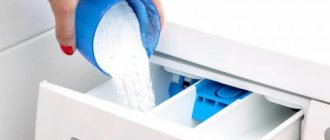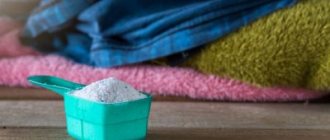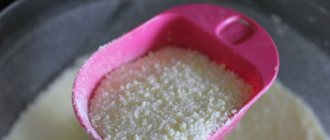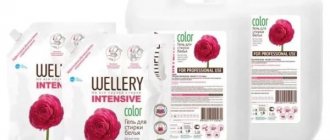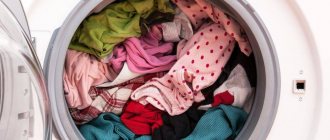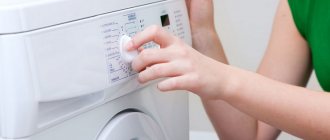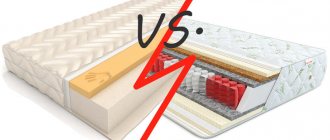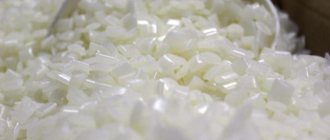What is better powder or gel for washing?
All laundry detergents have different compositions and washing properties. It is better for the housewife to have all types of detergents in her arsenal in order to use them based on the type of fabric and type of contamination.
A clear and familiar means for washing clothes is powder.
The washing gel has a gentle effect on fabric and is intended for clothes that require delicate handling. The liquid product is used at a temperature of no more than +40 degrees. High temperatures inhibit the effect of detergents that are present in the gels.
It is not suitable for dealing with stains and complex stains.
The use of liquid detergent for hand washing is ineffective. It is used for pre-soaking in warm water before washing in the machine, then the detergents work at full power.
The powder works in a wider temperature range of +30-90 degrees and copes better with stains and heavy dirt. It washes fabrics well when hand washed and is intended for dense materials: denim, cotton and linen.
Among the disadvantages is the obvious presence of phosphate compounds, which are harmful to human health and the environment.
But it dissolves in water worse than liquid compounds and is difficult to rinse out of fabric.
Loose powder is poorly stored, absorbs moisture from the air and turns into a lump, but this does not reduce its washing properties.
Powdered laundry detergents contain surfactants that can cause allergic reactions to chemicals.
There is a risk of the dry mixture entering the body, which is especially dangerous for sensitive people.
Liquid or bulk laundry detergent: consider the pros and cons
The production of household chemicals does not stand still and is constantly being improved, adapting to the needs of consumers and creating competitive products using new technologies and new approaches.
- minor repairs
- Sewer cleaning
This also applies to the production of laundry detergents. However, the more innovations appear on the market, such as liquid washing powders or gel pads, capsules that can simply be thrown into the machine along with washing, the more opponents of these products there are. Who is right and what is better - traditional bulk washing powder or newfangled liquid laundry detergents?
Let's try to weigh the pros and cons.
Washing temperature
At high temperatures, gels lose their effectiveness because... I work only with surfactants. On the one hand, this will allow the fabrics to remain in excellent condition longer and not look “washed out”, but on the other hand, this temperature (30-40 degrees) does not allow removing strong stains and penetrating into the structure of the fabrics, therefore for work clothes, jeans, linen and cotton fabrics, it is better to choose a powder that works more effectively at temperatures of 60-90 degrees. Use gel detergents for synthetics, wool, combined and delicate fabrics.
Washing quality
Liquid detergents refresh things and are more suitable for daily washing; hand washing with them is not effective, because... the substances contained in the gel require machine mechanical activation, which cannot be fully provided by the manual mode. But the powder is better at removing grease stains, traces of wine and grass, and whitens more effectively.
⇒ Order: An unusual gift for the home
Dosage
Washing powder rarely comes with a measuring spoon or glass, so we often just sprinkle it “by eye.” It’s much more convenient to pour liquid products and you don’t have to waste too much. Some options, such as soluble gel capsules or pads, can be simply thrown into the drum, because... The dosage in them is already calculated for 1 wash.
Allergic reactions
Dust from washing powder will somehow fly into the air, which can cause irritation to the eyes and respiratory tract. This situation is excluded with liquid laundry detergents.
Storage
Opened laundry detergent, regardless of packaging, may spill, break, or become damp. This will not happen with gels; a thick plastic bottle and a well-tightened cap will protect the contents in conditions of high humidity.
✏ Interesting: Be a man! Throw it away!
Dissolution quality
Loose laundry detergent dissolves throughout the entire wash cycle, which reduces its effectiveness, and sometimes does not dissolve completely, accumulating in the folds of clothes. This is especially dangerous for fabrics that are prone to shedding, because... the powder changes color and corrodes dyes where it accumulates. Undissolved washing powder “floats up” on dark clothes in the form of stains, streaks, and it is very difficult to get rid of this (especially if you saw it on a jacket before going to work).
Gel and liquid compositions are evenly distributed, do not have sediment and do not cause damage to fabrics and dyes if they are selected correctly. Another disadvantage of washing powder: it accumulates in the loading compartment and gradually turns into rocky deposits, not only deteriorating the quality of washing, but also greatly reducing the service life of the washing machine.
⇒ Order: Wooden stepladder
Relation to tissues
Gels: for expensive, delicate, surface-dyed fabrics and everyday washing;
Powder: for work clothes, thick fabrics, products made from dyed fibers, cotton bed linen, underwear made from natural fabrics (not delicates).
Saving
In terms of benefits, the gel clearly outperforms bulk formulations, because:
- There is a possibility of strict dosage;
- Washing at low temperatures saves energy;
- There is no need for additional rinsing, which means you save water.
Summing up
It would be wrong to compare gel and powder laundry detergents, because essentially these are different categories and replacing one with the other will not only be unprofitable, but also ineffective. Buy both, and use for different fabrics, different temperatures and different degrees of soiling.
✏ Interesting: How to choose a dress based on your body type
Advantages and disadvantages of washing gel
Any detergent has pros and cons that the housewife needs to know.
Gel is preferred by 50% of Russian women, but not many know that they cannot cope with severe dirt. The result is off-white and washed-out clothes.
Gels have long ceased to be a novelty; many people have already appreciated them from their own experience.
Pros of using a liquid product:
- Saving. Gels are produced in the form of a concentrate and for laundry weighing 5-7 kg, 50-100 ml is enough. This significantly saves the family budget.
- Convenience. The packaging is equipped with a measuring cap, with which liquid is poured into the washing machine compartment. The gel is produced in the form of capsules, they are convenient for storage and use.
- Solubility. The liquid consistency dissolves faster in water, the effect of detergents begins immediately when you start the machine.
- Hypoallergenic. The gel does not generate dust when poured into the machine, does not settle on fabric and rarely causes allergic reactions to chemicals.
- Rinsing. Liquid consistency dissolves better and is washed out of tissues.
- Delicate. It is gentle on thin materials and does not spoil the color or structure.
- Safe. The chemical composition is less aggressive for human health and nature.
This is a worthy replacement for powder and classic soap.
Components are added to liquid products that soften water and fabrics. There is no need to use fabric conditioner to rinse clothes.
There are also disadvantages in the gel. Its washing ability is significantly lower than that of washing powder. A delicate composition may not cope with old stains and heavy dirt. Washing is possible only at low temperatures +30-40 degrees. Increasing the temperature reduces the effectiveness of the gel.
One of the significant disadvantages is the impossibility of using the gel at high temperatures, since its structure is destroyed.
Liquid washing gels
Gels have become commonplace. Replace powder and classic laundry soap. Liquid products with a narrow focus (for delicate fabrics, wool, cashmere, dark-colored clothing, children's and sportswear) are popular among Russian consumers, but universal ones are used less often. In European countries, half of housewives prefer gel-like universal products.
The best qualities of gels are:
- convenient packaging that is easy to store even in a small bathroom;
- safety for the respiratory tract when opening the packaging and dosage of the gel;
- the product does not change consistency during storage;
- does not deform things, acting delicately on the fabric;
- no white spots on clothes after washing;
- the cap closing the container serves as a dispenser, which allows you to save product;
- does not contain phosphates.
A number of significant disadvantages prevent gels from completely replacing dry powder:
- high temperatures lead to destruction of the structure of the product, which reduces the cleaning ability of gels;
- soapy liquids do not cope well with difficult stains (oily stains) and are completely ineffective when working with old stains.
Baby washing gel
When a baby is born, you need to choose a liquid product more responsibly. Conventional formulations can cause allergies, skin irritation, and negatively affect the immune system of a fragile organism.
The gel gently cleanses things and does not cause texture deformation.
The best children's washing gels are based on soap with the addition of herbal ingredients with antibacterial action. The composition does not dry or irritate the skin, does not cause itching and does not contain fragrances that are harmful to the child.
Thanks to the special dispenser cap, you can pour the exact amount of the drug.
When purchasing, pay attention to the composition of the gel and exclude the following contents:
- Phosphates. They destroy the child’s immune system, which leads to frequent colds and complications.
- Chlorine. A toxic element that is dangerous not only for children, but also for adults. If clothes are not rinsed properly, chlorine causes severe allergies.
- Optical brightener. Causes skin irritation and itching.
- Surfactant It has a bad effect on the nervous system and can slow down the development of the child.
- Flavors. Strong and pungent odors are harmful to the baby's respiratory tract. Allergies and asthma may develop.
Environmentally friendly as it does not contain harmful chemicals.
To remove stains from a child’s clothes, rub the stained area with laundry soap and leave for 10 minutes. Soak the clothes for half an hour and wash as usual.
When purchasing baby gel, pay attention to the manufacturer's recommendations. The packaging indicates the composition and for what age the product is suitable.
According to statistics, more than 40% of Europeans prefer gel-based products.
What to choose for washing – gel or powder
In fact, both products are practically no different from each other in composition. Both in powders and in gels, you can find surfactants, phosphates, fragrances, bleaches, and defoamers. But there are still differences in them, and significant ones. Typically these are the amount of chemicals, the area of use and the leaching efficiency.
Pros and cons of powder
The advantages of using bulk products include:
- easily poured both into the drum and into the compartment for detergents in any required quantity;
- removes even the most difficult stains;
- effective at high water temperatures;
- contains elements that prevent the formation of scale;
- Can be used for hand washing as it foams well;
- when properly stored, retains all its properties for a long time;
- affordable price.
As for the disadvantages of the powder, they are, as a rule, few, but they are significant:
- high content of surfactants and phosphates, which are known to affect the impeccable cleanliness of linen;
- poor solubility in cold water;
- packaging - from an open package of powder, microparticles of harmful substances penetrate into the air and, as a result, cause allergies;
- poor washability (at least 8 rinsing cycles are required to properly dissolve phosphates);
- aggressive effect on some types of tissues, since it contains solid microparticles.
Pros and cons of gel
The advantages of using liquid household chemicals are:
- suitable for washing delicate fabrics;
- contains less surfactants and phosphates;
- washes out well, phosphates in most cases do not remain on clothes;
- harmful chemical additives do not spread into the air in the form of dust;
- practically do not subject the laundry to deformation;
- carefully influence the structure of the material and its color;
- quickly dissolve in water and, as a result, do not lead to blockages in the washing machine;
- do not leave stains or stains on clothes, as they do not settle in the fibers of the fabric;
- economical use due to precise dosage both in the cap and in the compartment for liquid detergents.
Flaws:
- do not prevent the formation of scale, as they do not contain protective dry components;
- less effective in the fight against complex, stubborn stains;
- are not effective at high temperatures because they lose their properties when exposed to hot water;
- not suitable for hand washing;
- short shelf life even with proper storage.
How to use washing gel correctly
Manufacturers produce several types of gels, which are divided according to the type of fabric and color of the linen. Universal compositions are suitable for any clothing. Bleaching agents have the delicate property of imparting whiteness to delicate fabrics. Gels for multi-colored fabrics retain color. Special compositions are made for black items, which saturate the shade of clothing.
The cleaning ability of gels, compared to dry products, is significantly lower.
The gel packaging is equipped with a measuring cap into which the gel is poured based on the amount of laundry in the washing machine. Add 30-50 ml of concentrate per 5 kg of clothing, the usual product is 100-150 ml, which is poured into the machine compartment.
You can use a special container that is placed in the drum along with the laundry.
The most convenient to use are capsules. You don’t need to pour them anywhere, just put them in your laundry and wash them. They quickly dissolve in water and do not require measurement.
The capsules already contain air conditioning, which is an additional saving of money.
Features of washing gels
Liquid detergents and capsules are not only effective, but also safe. They wash clothes to the maximum, regardless of the degree of soiling. The water temperature should be 30-40 degrees.
Each gel has a special composition, depending on the quality, color of the fabric and the level of contamination. For example, WELLERY INTENSIVE White gel is used to wash heavily soiled items. The results of its use are crystal whiteness, no harm to the material from chemicals.
Gels are mild detergents. They do not deteriorate the structure and color of the fabric. They extend the shelf life of products by approximately 30%.
Such products are easily soluble and contain no solid particles. They wash out well, after which there are no streaks left, and people can use things without fear for their health.
The gel is simply dosed using a measuring cap. Therefore, it is very economical, it lasts for more washes than simple powder. So from the point of view of benefits, such a tool has a clear advantage.
The bottle cap screws on tightly, so the gel does not leak out of it, even if it accidentally falls. You can buy a soft pack - a less expensive product and pour it into another container.
The gel cannot enter the respiratory tract during dosage, therefore it does not cause allergies.
It is difficult to remove grease and oil stains with liquid detergent, especially long-standing stains. For greater washing efficiency, these marks must be removed.
Gels have a short shelf life compared to powders and do not contain substances that remove scale from the machine.
However, the disadvantages of liquid laundry detergents are easily compensated for. There are gels with a large number of active substances. They remove dirt as effectively as powders without damaging fabrics.
Where to pour the gel
Some manufacturers of household appliances prohibit pouring liquid into the powder compartment. It is necessary to study the instructions for the washing machine to find out this issue. If prohibited, you need to use a container that is placed in the drum along with the laundry.
No harmful emissions when opening the package and pouring it into the washing machine, which is especially appreciated by allergy sufferers.
If the instructions have not been saved and there is no information on the Internet, look at the compartment with a compartment for the main wash. When the use of the gel is allowed, the compartment is blocked by a plastic flap, which regulates the flow of the liquid product at the right time.
In machines where the use of washing gels is allowed, there are three compartments in the detergent compartment.
The product is poured into the soaking and pre-wash compartment, the small left compartment. Large separation is the main process. The compartment on the right side is for air conditioning.
After opening the package, the gel does not crumble or turn into lumps.
Gel made from laundry soap and soda ash
Making your own detergent will save the family budget and will wash clothes no worse than store-bought counterparts. The gel can be used in the kitchen to wash dishes and surfaces. It washes off well with water, leaves no foreign odors and copes well with stains on clothes.
This product is suitable for children's underwear.
To prepare you need:
- Laundry soap – 100 gr.
- Soda ash – 150 gr.
- Water – 4 l.
- Aromatherapy oil – a few drops optional.
- Two pans for 1 and 3 liters.
Grate the soap on a fine grater, add 1 liter of water and bring to a boil. Dissolve baking soda in 3 liters of hot water. Pour the dissolved soap into a hot soda solution and add your favorite scent oil.
Does not leave white spots on laundry, as it easily dissolves and is washed off with water.
When cooled, the mass thickens, forming a gel. Transfer the product to a 4-liter container with a lid and use.
To use in the machine, it is better to pour the gel into a container and place it in the drum with the laundry. For 5 kg of laundry, 150-200 g is recommended. home remedy. Use with caution when washing wool and silk clothes. The gel is suitable for temperature ranges from 30-90 degrees.
It copes well with old stains when pre-soaked and for colored materials, no worse than Ariel.
What is the best liquid laundry detergent?
When you come to the store, you can be confused by the assortment of gels and their manufacturers. When choosing which liquid laundry detergent is best, base it on price and composition. Too cheap copies can be hazardous to health and contain large amounts of chemicals. When purchasing, pay attention to the average price category of gels - this is the best option for saving the family budget and delicate care of clothes.
Purchase products only from trusted manufacturers.
Rating of the best brands of liquid powder:
- Meine Liebe. It has a pleasant light aroma that is safe for children and does not cause allergies. The gel is available in concentrated form; 50-70 ml of product are consumed per 5 kg of laundry. Suitable for delicate fabrics and children's clothing from birth. Application temperature +40 degrees.
- Persil Color Expert Gel. Can be used for hand and machine wash. Produced in large volumes of 1.2-5.6 liters in the form of a concentrate. Contains phosphates and optical brightener and may not be safe for young children. Removes dirt and difficult stains well. It rinses completely out of the fabric, but leaves a lasting smell. Consumption per 5 kg of laundry is 60-160 ml depending on water hardness and type of contamination.
- Wellery Delicate Wool. Designed for clothing made of wool, silk and cashmere. Delicately washes, preserves the color of the product and the structure of the fabric. Suitable for hand washing, soaking and washing machine. Available in convenient packaging of 1-5 liters. Consumption per 5 kg of laundry is 25-50 ml at a temperature of +30 degrees.
- Synergetic. Suitable for all types of fabrics. Excellent for removing any stains. Maintains effectiveness at temperatures of +20-60 degrees. Does not spoil the color and preserves the structure of the material. Suitable for hand and machine wash. Available in volumes of 0.75-5 liters. Consumption per 5 kg of laundry: 50-100 ml.
- Weasel Active & Fresh. The product is intended for all types of fabrics, including sportswear with a membrane structure. Removes unpleasant odors well and leaves a pleasant aroma. Perfectly retains the color of the fabric even when soaked. Recommended application temperature is +30-40 degrees. Available in 1 liter volume. Consumption 50-70 ml.
Modern products do an excellent job of removing all types of contaminants in cold water. They are produced in the form of concentrates and are economical. They do not require maximum heating of water in the machine - this is an additional saving for the family budget on electricity bills.
What is the difference between washing gel and powder?
The main difference between gel and powder is consistency. In addition, the gel differs in its composition. Washing gel contains less anionic surfactants (surfactants).
Washing gel is more suitable for everyday washing; it freshens things well and has a gentler effect on the fabric structure. It is recommended to wash with gel at a temperature of 30-40 degrees. Best suited for washing wool and other delicate fabrics.
Powders are more suitable for washing at a higher temperature, for example 60-90 degrees, or for soaking. The powder copes much better with heavy stains.
